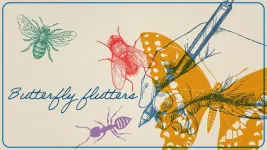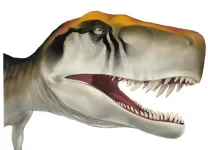(Press-News.org) UNIVERSITY PARK, Pa. — The sunflower family tree revealed that flower symmetry evolved multiple times independently, a process called convergent evolution, among the members of this large plant family, according to a new analysis. The research team, led by a Penn State biologist, resolved more of the finer branches of the family tree, providing insight into how the sunflower family — which includes asters, daisies and food crops like lettuce and artichoke — evolved.
A paper describing the analysis and findings, which researchers said may help identify useful traits to selectively breed plants with more desirable characteristics, appeared online in the journal Plant Communication.
“Convergent evolution describes the independent evolution of what appears to be the same trait in different species, like wings in birds and bats,” said Hong Ma, Huck Chair in Plant Reproductive Development and Evolution, professor of biology in the Eberly College of Science at Penn State and the leader of the research team. “This can make it difficult to determine how closely related two species are by comparing their traits, so having a detailed family tree based on DNA sequence is crucial to understanding how and when these traits evolved.”
The sunflower head, for example, is actually a composite composed of multiple much smaller flowers. While the head is generally radially symmetric — it can be divided into two equal halves in multiple directions like a starfish or a pie — the individual flowers can have different forms of symmetry. According to the new study, bilateral symmetry — where there is only one line that divides the flower into two equal halves — has evolved and been lost multiple times independently in sunflowers over evolutionary history. The researchers found that this convergent evolution is likely related to changes in the number of copies and the expression patterns of the floral regulatory gene, CYC2.
In recent years, many family trees for a group of related species have been built by extensively using transcriptomes, which are the genetic sequences of essentially all of the genes expressed by a species, the researchers explained. Transcriptomes are easier to acquire than high-quality whole-genome sequences for a species but are still difficult and costly to prepare and require fresh plant samples. To increase the number of species available for comparison the team turned to low-coverage genome sequences, which are produced through a process called genome skimming and are relatively inexpensive and easy to prepare, even from dried plant samples.
“To get an accurate whole-genome sequence for a species, each letter of its DNA alphabet must be read — or covered — multiple times to minimize errors,” Ma said. “For the purposes of building a family tree, we show in this paper that we can get away with lower coverage genome sequences. This allowed us to increase the number of species in our analysis, which, in turn, allowed us to resolve more of the finer branches on the sunflower family tree.”
The team used a combination of publicly available and newly generated transcriptomes, along with a large number of newly obtained skimmed genomes, for a total of 706 species with representatives from 16 subfamilies, 41 tribes and 144 subtribe-level groups in the sunflower family. The subfamilies are major subdivisions of the family, while the tribes and subtribe can contain one or more of genera, which is the classification level just above the species.
“Previous versions of the sunflower family tree had established the relationships among most of the subfamilies and many tribes, which are equivalent to the main branches of a tree,” Ma said. “With our increased sample size, we were able to resolve more of the smaller branches and twigs at the subtribe and genus level. This higher-resolution tree allowed us to reconstruct where and when traits like flower symmetry evolved, demonstrating that bilateral symmetry must have evolved many times independently.”
The team also studied the molecular evolution of genes involved in flower development among sunflowers. They found that one of these genes, CYC2, which is found in multiple copies in the genomes of each species, was activated in species with bilaterally symmetric flowers, suggesting that it might be part of the molecular basis for the convergent evolution of this trait. To further test this, the team performed experiments to quantify CYC2 gene expression in the flowers of species with different types of symmetry.
“Our analysis showed a clear relationship between CYC2 expression and flower symmetry, suggesting that changes in how these genes are used in various sunflower species is likely involved in the convergent evolution observed in the family,” Ma said. “The sunflower family is one of the two largest families of flowering plants containing over 28,000 species, including many economically important agricultural and horticultural species. Understanding how these species are related to one another allows us to determine how and when their traits evolved. This knowledge could also be used to identify useful traits that could be bred into domesticated species from closely related wild ones.”
In addition to Ma, the research team includes Guojin Zhang at Penn State; Junbo Yang, Jie Cai, Zhi-Rong Zhang and Lian-Ming Gao at the Kunming Institute of Botany in Kunming, China; Caifei Zhang at the Wuhan Botanical Garden and Sino-Africa Joint Research Centre in Wuhan, China; Bohan Jiao and Tiangang Gao at the State Key Laboratory of Plant Diversity and Specialty Crops in Beijing, China; and Jose L. Panero at the University of Texas, Austin.
Funding from the Eberly College of Science and the Huck Institutes of the Life Sciences at Penn State, the Strategic Priority Research Program of the Chinese Academy of Sciences, the Large-scale Scientific Facilities of the Chinese Academy of Sciences, and the National Natural Science Foundation of China supported this research.
END
New sunflower family tree reveals multiple origins of flower symmetry
2024-04-03
ELSE PRESS RELEASES FROM THIS DATE:
Lurie Children’s Hospital first in Illinois to treat Duchenne muscular dystrophy with FDA-approved gene therapy
2024-04-03
On March 27, 2024, Ann & Robert H. Lurie Children’s Hospital of Chicago treated its first patient with ELEVIDYS (delandistrogene moxeparvovec-rokl), the first gene therapy for Duchenne muscular dystrophy – a rare, genetic disease characterized by progressive muscle damage and weakness. Lurie Children’s is the first in Illinois to administer this treatment after ELEVIDYS received U.S. Food and Drug Administration (FDA) approval in June 2023.
Developed by Sarepta Therapeutics, ELEVIDYS is approved for the treatment of Duchenne muscular dystrophy (DMD) in ambulatory patients aged 4 through 5 years with ...
Butterflies, bees, ants and flies are the most widely referenced arthropods in a sample of almost 4,000 haiku - which commonly describe their color, flight and ecology
2024-04-03
Butterflies, bees, ants and flies are the most widely referenced arthropods in a sample of almost 4,000 haiku - which commonly describe their color, flight and ecology
###
Article URL: https://journals.plos.org/plosone/article?id=10.1371/journal.pone.0298865
Article Title: Diversity and complexity of arthropod references in haiku
Author Countries: USA
Funding: The author(s) received no specific funding for this work. END ...
Might your personality affect how you move? Runners classified as Myers-Briggs "Sensing" types have a more grounded running style in experiments than those classified as "Intuition" types
2024-04-03
Might your personality affect how you move? Runners classified as Myers-Briggs "Sensing" types have a more grounded running style in experiments than those classified as "Intuition" types
###
Article URL: https://journals.plos.org/plosone/article?id=10.1371/journal.pone.0300108
Article Title: Mind to move: Differences in running biomechanics between sensing and intuition shod runners
Author Countries: France, Switzerland, Belgium
Funding: The author(s) received no specific funding for this work. END ...
Early dinosaurs grew up fast, but they weren’t the only ones
2024-04-03
The earliest dinosaurs had rapid growth rates, but so did many of the other animals living alongside them, according to a study published April 3, 2024 in the open-access journal PLOS ONE by Kristina Curry Rogers of Macalester College, Minnesota and colleagues.
Dinosaurs grew up fast, a feature that likely set them apart from many other animals in their Mesozoic (252 to 66 million years ago) ecosystems. Some researchers have proposed that these elevated growth rates were key to the global success of dinosaurs, but little is known about the growth strategies of the earliest dinosaurs. In this study, Rogers and colleagues performed histological analysis, examining patterns of bone ...
Working outside the typical 9–5 in younger adulthood may be linked with worse health decades later
2024-04-03
The hours you work earlier in life may be associated with worse health years later, according to a study published April 3, 2024 in the open-access journal PLOS ONE by Wen-Jui Han from New York University, US.
Studies have consistently shown that nonstandard work schedules—working outside the traditional nine-to-five workday—can negatively impact physical and mental health as well as social and family life. The current study uses a life-course approach to provide a longer-term perspective on how work schedule ...
Demand for critical minerals puts African Great Apes at risk
2024-04-03
A recent study led by researchers from the German Centre for Integrative Biodiversity Research (iDiv), the Martin Luther University Halle-Wittenberg (MLU) and the non-profit conservation organization Re:wild shows that the threat of mining to the great ape population in Africa has been greatly underestimated. Their results have been published in Science Advances.
The rising demand for critical minerals, such as copper, lithium, nickel, cobalt, and other rare earth elements required for the large-scale transition to cleaner energy is causing a surge of mining in Africa, where a large share of those mineral resources is still unexploited. ...
Tourism to Yellowstone National Park produces more than a billion kilos of CO2 emissions annually
2024-04-03
Tourism to Yellowstone National Park produces more than a billion kilos of CO2 emissions annually, with 90% arising through travel to and from the park, especially from visitors arriving by plane.
####
Article URL: https://journals.plos.org/climate/article?id=10.1371/journal.pclm.0000391
Article Title: Quantifying and evaluating strategies to decrease carbon dioxide emissions generated from tourism to Yellowstone National Park
Author Countries: United States
Funding: This work was supported by the Utah Agricultural Experiment Station (Project ...
Air quality in schools: Shielding kids with intellectual and developmental disabilities from COVID
2024-04-03
During the pandemic, University of Rochester Medical Center (URMC) researchers, including those from the Intellectual and Developmental Disabilities Research Center (IDDRC), teamed up with the Mary Cariola Center to study ways to prevent COVID infection among children with intellectual and developmental disabilities (IDD), a particularly vulnerable population. Together, they found that good airflow and filtration in schools may help these children and their teachers avoid COVID infections.
The COVID pandemic was a particularly difficult balancing act for children with IDDs and their ...
JAX researchers make mice a more powerful tool to study a wide range of human diseases
2024-04-03
In humans, the exact same mutation in a specific gene can produce widely different outcomes. It’s a bit like adding the same amount of salt to different recipes—the effect on the finished dish can be quite different, depending on the mix of other ingredients. Now, researchers at The Jackson Laboratory (JAX) have developed a powerful platform to study the reasons behind these varying mutation outcomes. The work, published today in Science Advances, not only provides new opportunities for uncovering targets for therapeutic interventions but also represents a significant step forward in addressing the critical need ...
Immunotherapy for Alzheimer’s disease shows promise in mouse study
2024-04-03
Alzheimer’s disease starts with a sticky protein called amyloid beta that builds up into plaques in the brain, setting off a chain of events that results in brain atrophy and cognitive decline. The new generation of Alzheimer’s drugs — the first proven to change the course of the disease — work by tagging amyloid for clearance by the brain’s immune cells.
Now, researchers at Washington University School of Medicine in St. Louis have found a different and promising way to remove the noxious plaques: by directly mobilizing immune cells to consume ...








